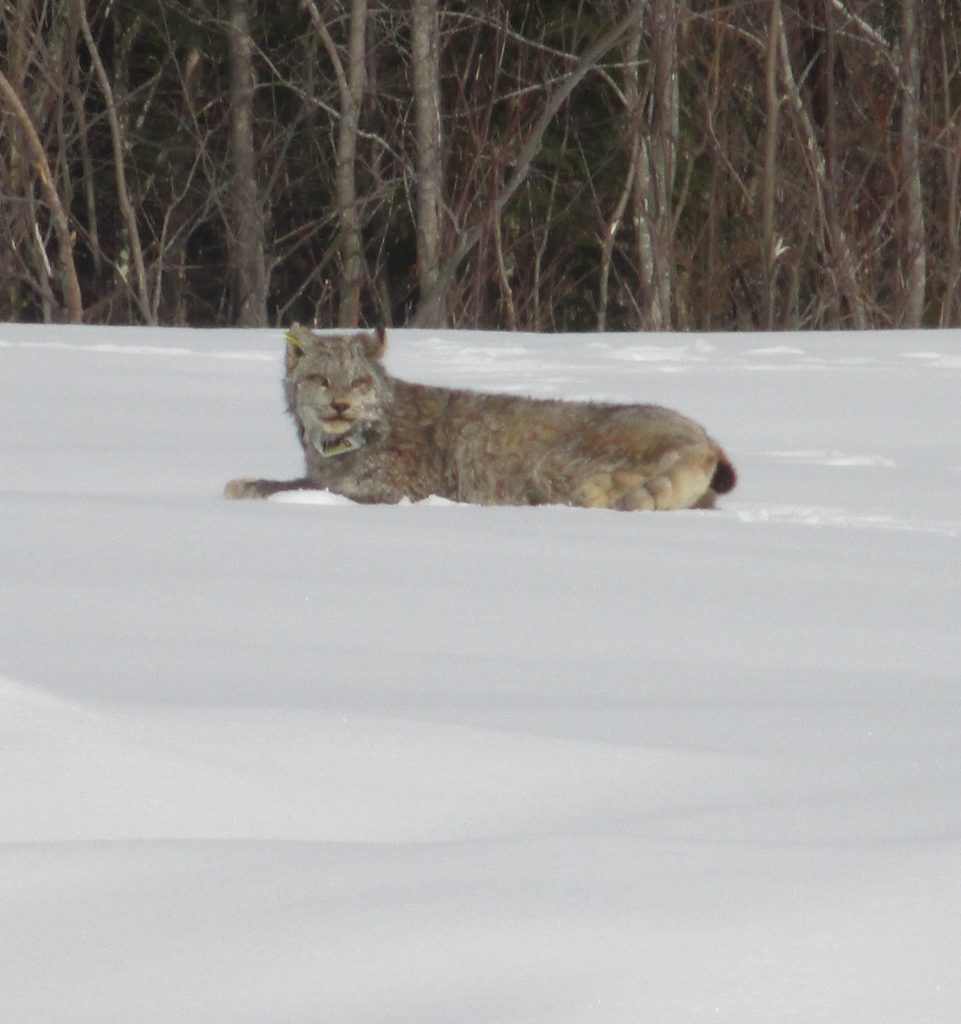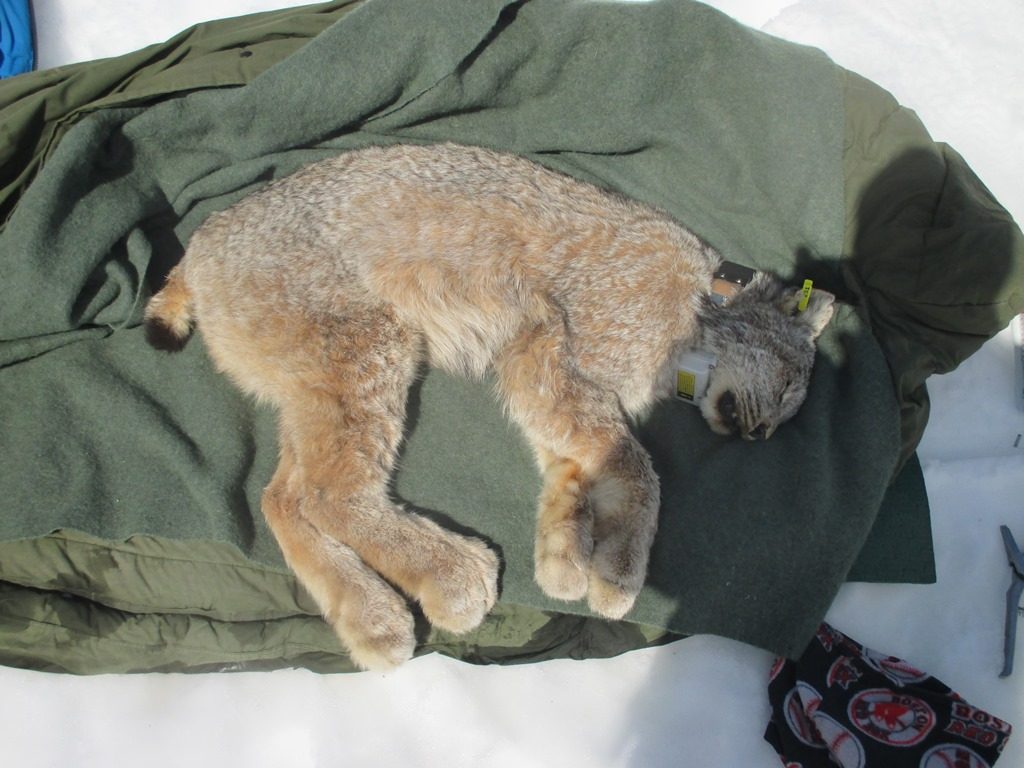April 12, 2017 at 3:06 pm
[caption id="attachment_2263" align="alignright" width="518"] This lynx with an attached GPS collar, was collared and released earlier this winter. Biologists will track this lynx for up to five years, and will visit her den if she has kittens.[/caption]
By IFW Wildlife Biologist Scott McLellan
Between 1999 and 2011, the Maine Department of Inland Fisheries and Wildlife researched lynx in northwestern Aroostook County in order to assess demographic rates and sources of mortality.
Lynx were captured and equipped with radio collars, and subsequently monitored so that wildlife biologists could collect and analyze the information.
In more recent years, MDIFW has been interested in collecting information on lynx in other areas of the state where habitat characteristics, prey and predator densities, and human presence are different than the original Aroostook study area.
During the winter of 2017, wildlife biologists selected an area in the Moosehead Lake region to set cage-style traps for lynx in order to attach GPS collars and ear tags. When captured, lynx are anesthetized, vitals are monitored, a GPS collar and numbered ear tags are attached, DNA samples (i.e. blood, hair, tissue) are collected, and numerous morphological measurements are recorded.
This process takes about one hour before the immobilizing agents are reversed and the lynx is allowed to recover.
[caption id="attachment_2262" align="alignleft" width="1024"]
This lynx with an attached GPS collar, was collared and released earlier this winter. Biologists will track this lynx for up to five years, and will visit her den if she has kittens.[/caption]
By IFW Wildlife Biologist Scott McLellan
Between 1999 and 2011, the Maine Department of Inland Fisheries and Wildlife researched lynx in northwestern Aroostook County in order to assess demographic rates and sources of mortality.
Lynx were captured and equipped with radio collars, and subsequently monitored so that wildlife biologists could collect and analyze the information.
In more recent years, MDIFW has been interested in collecting information on lynx in other areas of the state where habitat characteristics, prey and predator densities, and human presence are different than the original Aroostook study area.
During the winter of 2017, wildlife biologists selected an area in the Moosehead Lake region to set cage-style traps for lynx in order to attach GPS collars and ear tags. When captured, lynx are anesthetized, vitals are monitored, a GPS collar and numbered ear tags are attached, DNA samples (i.e. blood, hair, tissue) are collected, and numerous morphological measurements are recorded.
This process takes about one hour before the immobilizing agents are reversed and the lynx is allowed to recover.
[caption id="attachment_2262" align="alignleft" width="1024"] The lynx are trapped and then sedated. Once they are sedated, biological data is collected, ear tags affixed and a GPS collar is attached to the lynx. You can see that tags and the collar on the lynx on the right side of the lynx in the shadows.[/caption]
Following this event, wildlife biologists monitor each animal from both the ground and a computer to ensure proper movement. Adult females will be monitored very closely during spring to determine whether or not they have successfully denned. If successful, dens will be visited to record the number of kittens, and to mark each kitten with ear tags and transponder chips. This research is expected to last approximately five years, or until the radio collar batteries have all expired.
The lynx are trapped and then sedated. Once they are sedated, biological data is collected, ear tags affixed and a GPS collar is attached to the lynx. You can see that tags and the collar on the lynx on the right side of the lynx in the shadows.[/caption]
Following this event, wildlife biologists monitor each animal from both the ground and a computer to ensure proper movement. Adult females will be monitored very closely during spring to determine whether or not they have successfully denned. If successful, dens will be visited to record the number of kittens, and to mark each kitten with ear tags and transponder chips. This research is expected to last approximately five years, or until the radio collar batteries have all expired.
 This lynx with an attached GPS collar, was collared and released earlier this winter. Biologists will track this lynx for up to five years, and will visit her den if she has kittens.[/caption]
By IFW Wildlife Biologist Scott McLellan
Between 1999 and 2011, the Maine Department of Inland Fisheries and Wildlife researched lynx in northwestern Aroostook County in order to assess demographic rates and sources of mortality.
Lynx were captured and equipped with radio collars, and subsequently monitored so that wildlife biologists could collect and analyze the information.
In more recent years, MDIFW has been interested in collecting information on lynx in other areas of the state where habitat characteristics, prey and predator densities, and human presence are different than the original Aroostook study area.
During the winter of 2017, wildlife biologists selected an area in the Moosehead Lake region to set cage-style traps for lynx in order to attach GPS collars and ear tags. When captured, lynx are anesthetized, vitals are monitored, a GPS collar and numbered ear tags are attached, DNA samples (i.e. blood, hair, tissue) are collected, and numerous morphological measurements are recorded.
This process takes about one hour before the immobilizing agents are reversed and the lynx is allowed to recover.
[caption id="attachment_2262" align="alignleft" width="1024"]
This lynx with an attached GPS collar, was collared and released earlier this winter. Biologists will track this lynx for up to five years, and will visit her den if she has kittens.[/caption]
By IFW Wildlife Biologist Scott McLellan
Between 1999 and 2011, the Maine Department of Inland Fisheries and Wildlife researched lynx in northwestern Aroostook County in order to assess demographic rates and sources of mortality.
Lynx were captured and equipped with radio collars, and subsequently monitored so that wildlife biologists could collect and analyze the information.
In more recent years, MDIFW has been interested in collecting information on lynx in other areas of the state where habitat characteristics, prey and predator densities, and human presence are different than the original Aroostook study area.
During the winter of 2017, wildlife biologists selected an area in the Moosehead Lake region to set cage-style traps for lynx in order to attach GPS collars and ear tags. When captured, lynx are anesthetized, vitals are monitored, a GPS collar and numbered ear tags are attached, DNA samples (i.e. blood, hair, tissue) are collected, and numerous morphological measurements are recorded.
This process takes about one hour before the immobilizing agents are reversed and the lynx is allowed to recover.
[caption id="attachment_2262" align="alignleft" width="1024"] The lynx are trapped and then sedated. Once they are sedated, biological data is collected, ear tags affixed and a GPS collar is attached to the lynx. You can see that tags and the collar on the lynx on the right side of the lynx in the shadows.[/caption]
Following this event, wildlife biologists monitor each animal from both the ground and a computer to ensure proper movement. Adult females will be monitored very closely during spring to determine whether or not they have successfully denned. If successful, dens will be visited to record the number of kittens, and to mark each kitten with ear tags and transponder chips. This research is expected to last approximately five years, or until the radio collar batteries have all expired.
The lynx are trapped and then sedated. Once they are sedated, biological data is collected, ear tags affixed and a GPS collar is attached to the lynx. You can see that tags and the collar on the lynx on the right side of the lynx in the shadows.[/caption]
Following this event, wildlife biologists monitor each animal from both the ground and a computer to ensure proper movement. Adult females will be monitored very closely during spring to determine whether or not they have successfully denned. If successful, dens will be visited to record the number of kittens, and to mark each kitten with ear tags and transponder chips. This research is expected to last approximately five years, or until the radio collar batteries have all expired.Categories